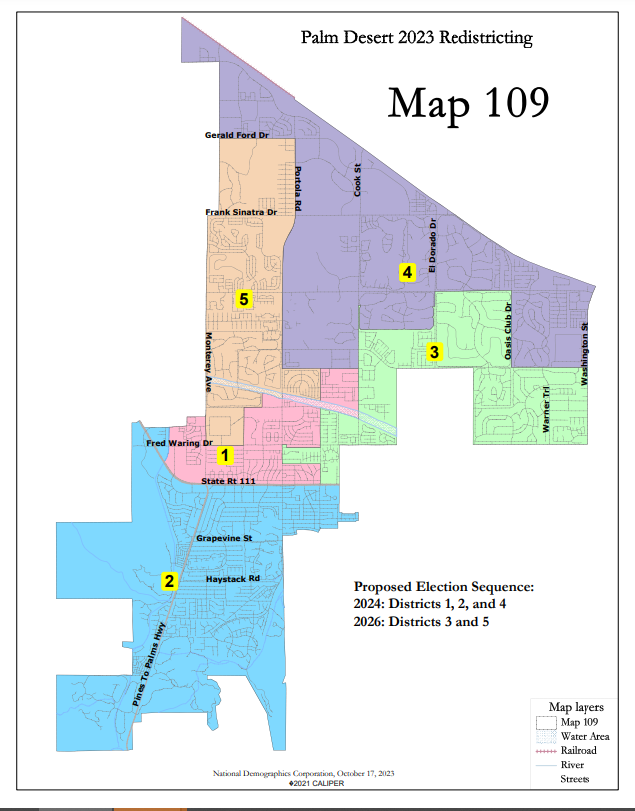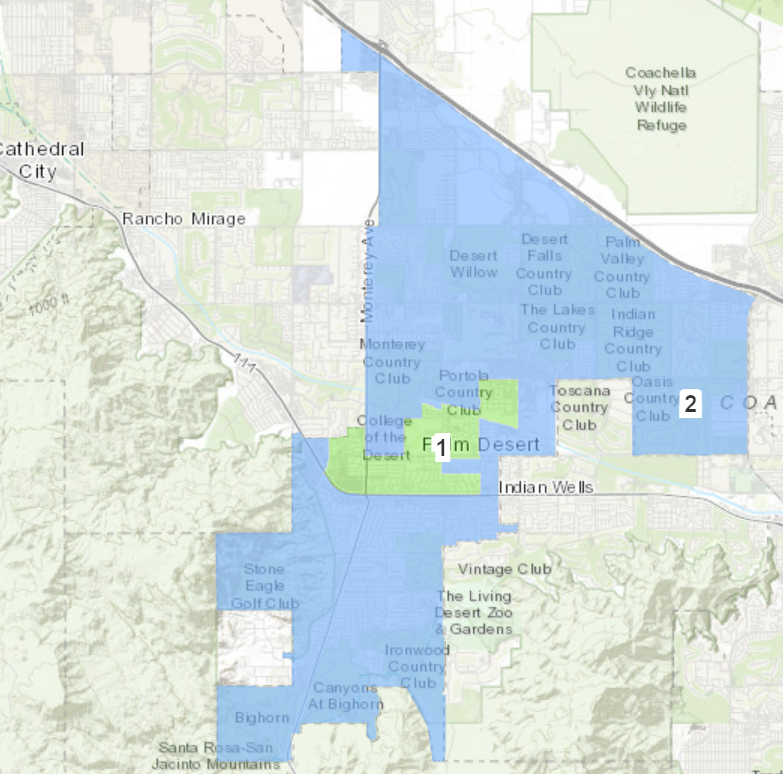Palm Desert council's favored district map draws criticism for splitting city's north end
A divided Palm Desert City Council has signaled it favors a new voter map that would split the city's fast-growing northern end between two council districts — an idea that drew opposition from some residents and one council member.
The council didn't formally adopt the new map, but after a redistricting hearing last week, it selected a single “focus map” to present for further public feedback and possible fine-tuning, with plans to choose a final map in mid-December.

The debate comes as Palm Desert transitions to a five-district council system that will be in place for the 2024 election.
The council’s decision drew pushback from Mayor Pro Tem Karina Quintanilla, who urged the council to advance multiple options for further discussion, as well as a couple residents who spoke at the meeting.
The switch from two to five council districts was approved by the council in June, after a majority of the city’s voters — roughly 53% — supported the move on an advisory ballot measure in last year’s general election.
Under the city’s current setup, residents of District 2 — which includes about 80% of the city’s population — vote for four councilmembers, while the smaller District 1 — which covers the Civic Center area and surrounding neighborhoods — has one representative.
The council is now deciding how to divvy up District 2 into four separate districts, while District 1 — which was the product of a voting rights lawsuit filed in 2019 — is expected to remain intact.
While the agenda for the Nov. 16 meeting said the council planned to select two to three map options, the council ultimately voted to advance only one, saying other proposals would’ve divided a clear “community of interest” by splitting a gated community into two districts.
From two to five districts: How did we get here?
Palm Desert had at-large voting for its five council seats until 2019, when two residents filed a lawsuit against the city saying it was in violation of the California Voting Rights Act, which requires cities to ensure minority voting groups have a fair chance for representation.
That lawsuit led to the two-district setup. While Latino residents make up just over a quarter of its population, Palm Desert didn't have its first Latina council member until Quintanilla — one of the suit's plaintiffs — won election in District 1 after it was created in 2020.

Roughly 44% of the voting-age population in District 1 is Latino, and city officials say any reductions in that percentage could risk a legal challenge, meaning the council is largely focused on drawing four other districts around the existing one.
What are the focus map's districts?
The city accepted publicly submitted maps for several weeks this fall, and officials have worked with National Demographics Corporation to develop other options and adjust maps from the public that didn’t properly balance the city’s population across the five districts.
The map advanced by the council last week, which was submitted by the demographer, would dive the city into the following districts:
District 1 would remain the same as its current version, covering Civic Center Park and some surrounding areas along Fred Waring Drive and north of Highway 111.
District 2 would cover all of the city south of Highway 111, as well as a small area on the west end of Highway 111 on the opposite side of the road.
District 3 would largely go around the city limits of Indian Wells, extending east to Washington Street. It would include all of the Palm Desert Country Club, The Oasis Country Club and Indian Ridge Country Club, as well as the Hidden Palms gated community.
District 4 would have all of Interstate 10 as its northern border, extending east to the Woodhaven Country Club. It would also include the Spanish Walk community, the Desert Willow Golf Resort and the areas surrounding the city’s campuses affiliated with California State University-San Bernardino and University of California-Riverside.
District 5 would largely be between Portola Road and Monterey Avenue, running south of Gerald Ford Drive down to College of the Desert. It would include Monterey Country Club, Chaparral Country Club, Suncrest Country Club and The Regent Palm Desert.
Under the proposed map, known as Map 109, the council election for Districts 1, 2 and 4 would be held in 2024, while the election for District 3 and 5 would be in 2026.
What the public said
A couple residents spoke during the redistricting hearing Thursday, both offering their support for a different option — Map 102b — than the one advanced by the council.
That map was submitted by Gregg Akkerman, who ran for a city council seat in last year’s election. His map would create a district covering the city’s northern end, from Interstate 10 south to Country Club Drive, except for a small area east of Tamarisk Row Drive.
Housing is set to triple in the area in the coming years, with more than 4,500 units either under construction or approved by the city. While Akkerman's map would place most of that growth — about 4,200 homes — in a single northern district, the option backed by the council would place nearly 1,500 of those future homes in one district, while roughly 3,100 planned homes would be in a different one, per city estimates.
Speaking to the council Thursday, Akkerman took issue with that approach, saying it would dilute the perspective of residents of the city’s northern region.
“Residents in the north of Palm Desert often cite living conditions considerably different than the rest of the city due to things like wind and sand, which binds them together as a community of interest,” Akkerman said. “And yet these two maps propose districts that would run from the northern reaches of the city all the way to the south as far as Fred Waring Drive.”
Akkerman also noted all of the city north of Frank Sinatra Drive falls into the Palm Springs Unified School District, but that community of interest would be split under the proposal advanced by the council.
Resident Ralph Perry also backed Akkerman’s map and said it “would make the most sense” to residents.
Beyond the two people who spoke Thursday, 10 others said they were in favor of Akkerman’s map in written comments to the council. A couple others said they supported a different map drawn by the demographer — Map 104 — while one anonymous person said the council should split the city’s northern area in two.
What the council said
Most of the council took issue with how Akkerman’s map would divide Hidden Palms, a gated community south of Fred Waring Drive and east of Deep Canyon Drive, into two districts.
Mayor Kathleen Kelly said the splitting of a gated community strikes her as “the most extreme failure to respect a community of interest.” Councilmember Jan Harnik agreed, saying it’s “absolutely unacceptable” to divide a gated community in half.
Kelly also said Map 109 — which keeps Hidden Palms in one district — was the only option in which the entire mid-valley flood channel would run through a single district. The city is currently working with an engineer firm to assess the root causes of the flooding from Tropical Storm Hilary that damaged homes in the Spanish Walk community near Interstate 10 in August.
“That strikes me again as respecting a very strong community of interest,” Kelly said. She also noted Map 109 would place Portola Country Club in the same district as Palm Desert Greens Country Club, two developments that have mobile homes and overlapping issues often brought to city hall.
Councilmember Evan Trubee said that while there’s no “perfect solution,” he favored Map 109, adding it would better accommodate the growth in north Palm Desert expected to occur in the next few years.
“If we go with anything but Map 109, we’re going to have a major redrawing when those censuses (in 2030 and beyond) come out, and I'd rather have more predictability and stability moving forward,” Trubee said.
The council’s favoring of that map drew criticism from Quintanilla, who said other members’ focus on gated communities “goes against the whole concept of why I even presented the (voting rights) lawsuit.” She said the splitting of a gated community would not be “the end of the world.”
“The city of Palm Desert needs to look at residents that live outside of the gated communities and respect their needs as well,” Quintanilla said.
Quintanilla also noted the meeting’s agenda states the council would advance two or three options for further discussion, rather than select a single “focus map.”
“If we narrow it down to one, we are stealing from our voters,” Quintanilla said. “We are suppressing their voice and saying, ‘Tell us what you think of this one choice.’”
Quintanilla then moved to advance both the map favored by the rest of the council, as well as the Akkerman map, but her motion failed without any further support. Kelly also pushed back against her comments, noting the city held several workshops and hearings in recent weeks to gather public input.
By a 4-1 vote, with Quintanilla opposed, the council then agreed to advance only Map 109 as its focus map for gathering more feedback and refining the lines in its upcoming meetings.
What's next?
With the council planning to select a final map in mid-December, the public will have another chance to weigh in during a community workshop at 6 p.m. Nov. 26. The in-person meeting will be at the Palm Desert iHub, located at 37023 Cook St., Suite 102.
A hybrid workshop will then be held at 6 p.m. Dec. 6. That meeting can be attended in person at Palm Desert City Hall or via Zoom, with more information at redistrictpd.org.
The council will then select its final map during a public hearing slated for 4:30 p.m. Dec. 14. Two subsequent hearings will be held Jan. 11 and 25, during which the council plans to introduce and adopt an ordinance enacting the new districts and getting rid of ranked-choice voting.
Tom Coulter covers the cities of Palm Desert, La Quinta, Rancho Mirage and Indian Wells. Reach him at thomas.coulter@desertsun.com.
This article originally appeared on Palm Springs Desert Sun: Palm Desert council criticized over proposed district map

